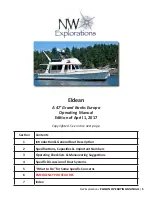
34
BASIC RULES FOR BATTERY CARE AND MAINTENANCE
BASIC RULES FOR BATTERY CARE AND MAINTENANCE
Check liquid level in all cells once every week or two . Add water as required . Bring liquid
level to 3/8 inch above top of separators . It is much better to add water in small amounts
frequently, than to put too much in and flood out the electrolyte, thus causing damage to
adjacent wiring and equipment, plus loss of acid . Generally, the local drinking water in the
United States is safe for use in batteries; but to be sure, check with your battery supplier .
1) Add water only . Add no battery dopes, special liquid, or powders . These are harmful or useless .
Before adding water, take a hydrometer reading of one cell . (Don’t use same cell each time;
change around) . If above 1 .225 Specific Gravity, battery is sufficiently charged .
If below 1 .225 Specific Gravity, remove battery for bench charge . If level is too low to read, add
water and take hydrometer reading the next day .
2) After adding water, examine hold-downs . Make certain battery is secure . Hold-downs should
make a snug fit, but not necessarily the tightest fit, or the container may be forced out of shape .
3) Examine cables and terminals for tightness, corrosion, and wear . Corrosion occurs from the
spilled electrolyte getting on metal, other than lead . Lead does not corrode . To remove corro-
sion, scrape or brush it off . Then immerse the part in an alkaline solution, such as baking soda,
in the proportions of one pound soda to a gallon of water . One can tell when the electrolyte
is neutralized by observing when the bubbling stops . Wash with water, dry, and apply silicone
grease available from battery dealers .
4) Examine battery for broken or cracked covers, case, and cracks in sealing compound . If any of
the above defects are present, remove battery at once and have repaired . Acid loss from any
of the above defects will shorten battery life . Acid escaping through cracked covers or sealing
compound will cause corrosion of terminals, cables, carrier, and adjacent parts .
5) Batteries should be re-charged, if hydrometer reading is below 1 .225 . DO NOT LEAVE A BATTERY
ON CHARGE FOR MORE THAN 48 HOURS .
6) STOP CHARGE when two hydrometer readings recorded two hours apart show no increase, or
when terminal voltage readings recorded two hours apart show no increase . If there is no rise
in voltage or specific gravity in a period of two hours, further charging is USELESS and MAY
DAMAGE BATTERY BEYOND REPAIR . Have your supplier check battery for possible acid adjust-
ment or repair .
7) On this bench re-charge, the specific gravity is expected to read certain values before considered
serviceable for continued use . The hydrometer reading should be above 1 .260 . The full charge
gravity when new was 1 .270–1 .290 . If battery does not register as above, have your battery
supplier inspect it . He may be able to adjust acid or make repairs .
8) In cold weather, do not fill cells with water and let stand without running motor long enough to
allow water to mix with acid, as freezing might occur .
9) Spare batteries should be re-charged at least every 4 or 5 weeks, in order that the Specific Grav-
ity may be maintained at 1 .240 or above .
10) Use a battery with sufficient ability to carry the connected load .
11) Wash dirt and corrosion off top of battery to eliminate inter-cell discharge .
Содержание CAL 27 Mk III
Страница 1: ...Owner s Manual ...
Страница 6: ...6 CAL 27 Mk III BOAT DIMENSIONS ...
Страница 7: ...CAL 27 Mk III BOAT DIMENSIONS 7 BANGOR PUNTA MARINE CAL 27 III ARRANGEMENT 10 28 1982 JPF ...
Страница 13: ...Wire Rigging 13 WIRE RIGGING ...
Страница 26: ...26 WATER SYSTEM BANGOR PUNTA MARINE CAL 27 III STANDARD WATER SYSTEM 10 6 1982 JPF ...
Страница 27: ...WATER SYSTEM 27 BANGOR PUNTA MARINE CAL 27 III PRESSURE WATER OPTION 10 6 1982 JPF ...
Страница 29: ...COOKING STOVES PROPANE STOVES 29 BANGOR PUNTA MARINE CAL 27 III THRU HULL LOCATIONS 10 6 1982 JPF ...
Страница 38: ......

































